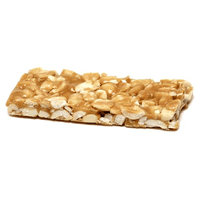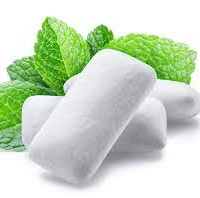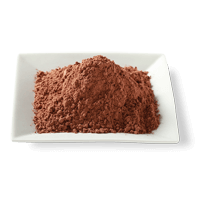Halva Nutrition & Calories - Complete Data of All Nutrients
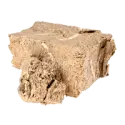
Introduction
Halva is commonly consumed as a confection or dessert in Middle Eastern, Mediterranean, and Balkan countries. Halva is high in nutrients and has a delicious flavor. This article will discuss the nutritional profile of halva in detail.
Table of contents
What is Halva?
The term halva, also known as halaweh, halvah, or halwa, is used to describe a type of confectionery made from various ingredients.
Halva is usually made using seeds, nuts, or grain flour as a base and sugar, maple syrup, or honey as a sweetener. Naturally, halva's nutritional properties can greatly vary depending on these ingredients.
The most popular types of halva use sesame seeds, sunflower seeds, flour, cornstarch, or peanuts as base.
The nutritional and physicochemical characteristics of halva also depend on added ingredients, such as butter, vegetable oil, vanilla, pistachios, cocoa powder, chocolate, milk, egg whites, saffron, rose water, and many others.
Halva has a distinct flavor and a rich yet delicate texture. Depending on the variety, the texture can also differ from soft and buttery to dry and crumbly.
Nutrition
The numbers in the infographic charts on our page are taken from the USDA Foods Database, showcasing the nutritional values of a 100g serving of plain halva.
However, one average serving of halva per person is considered 1 ounce or 28.35g.
Refer to the following link for a detailed exploration of halva health benefits and side effects.
Carbohydrates
Carbohydrates are the main macronutrient found in halva, making up about 60% of the total content. A 100g serving of halva provides 60.5g of carbohydrates, of which 56g or 92.5% is made up of net carbs and 4.5g or 7.5% is dietary fiber.
An average serving size of halva (1oz or 28.35g) provides 17g of carbohydrates. Plain halva falls in the top 9% of foods as a source of carbohydrates in our food database. Thus, halva is not suitable for low-carb diets.
Macronutrients chart
The number of carbohydrates is directly connected to the constituents of halva.
The high content of carbohydrates is primarily due to the added sweeteners, such as sugar, maple syrup, and honey. It is safe to assume that most of the net carbs found in halva would be sucrose if white sugar or maple syrup has been used in the recipe and fructose and glucose in the case of honey.
The fiber content is usually provided by the seeds, nuts, or grain products used to make halva. However, the nuts and seeds are usually dehulled, and the grains are usually milled in making this dessert, lowering their fiber content.
Research states that the composition of sesame halva is characteristically high in sugars (47.7%), fat (32.4%), and proteins (13.7%) but low in dietary fibers (1.5%) (1).
Fats
Halva is relatively high in fats due to the added butter or vegetable oils. It falls in the top 14% of foods as a source of fats, containing 21.52g per 100g or 6.1g per 1oz serving.
Of these fats, 4.13g (20%) is saturated, 8.2g (39%) is monounsaturated, and 8.5g (41%) is polyunsaturated. While most of the fatty acids found in halva are unsaturated, it also has a high content of saturated fats.
Research shows plain-type halva to contain a high-fat content of about 34% (2). Studies on sunflower halva have found its fat content to be even higher, falling from 37% to 44% (3).
The fat content of halva consists mainly of oleic (omega-9 monounsaturated fatty acid) and linoleic acids (omega-6 polyunsaturated fatty acids), with lower amounts of palmitic (saturated long-chain fatty acid) and stearic acids (saturated fatty acid) (2).
Halva has no trans fats.
Fat type information
As a plant product, halva naturally contains no cholesterol.
Protein
Proteins are essential macronutrients that play critical roles in the human body's structure, function, and regulation of cells and tissues. Halva contains 12.49g of protein per 100g. Halva is relatively high in tryptophan, threonine, isoleucine, phenylalanine, valine, lysine, and histidine.
Based on tahini paste, Sesame halva provides higher levels of methionine, cysteine, and tryptophan (2).
Phytochemicals
The phytochemicals found in halva are usually in low amounts and provided by the seed, nut, or grain base used. In this section, we will focus on the nutritional properties of sunflower and sesame seeds, as these are the most common ones used as halva bases.
Polyphenols
Research has demonstrated that sesame seeds are particularly rich in free phenolic compounds, flavonoids, and bound polyphenols (4).
Sesame seeds have a few characteristic lignans, such as sesamin, sesamol, and anthrasesamone F, which have been shown to exhibit antioxidant and antiaging effects. Furthermore, sesamin and sesamolin have been shown in multiple studies to have anti-inflammatory, antihypertensive, and anticarcinogenic properties (4).
Sunflower seeds have been researched to be high in flavonoids, such as heliannone, quercetin, kaempferol, luteolin, apigenin, and phenolic acids, such as caffeic acid, chlorogenic acid, caffeoylquinic acid, gallic acid, protocatechuic, coumaric, ferulic acid, and sinapic acids (5).
Due to these compounds, sesame and sunflower seeds have strong antioxidant and antiproliferative qualities.
Tocopherols
Tocopherols are natural fat-soluble vitamins (vitamin E) with potent antioxidant qualities. There are four tocopherol derivatives: alpha, beta, gamma, and delta. Sunflower seed is richest in alpha tocopherols, with the strongest antioxidant potential (5).
Sesame seeds are also high in tocopherols. Research has shown that the lignan phytochemicals found in these seeds may help boost the antioxidant activity of tocopherols.
It is important to note that while sesame and sunflower seeds are rich in phytochemicals, the cleaning, dehulling, roasting, and grinding processes used to make halva significantly reduce the level of these nutrients.
Saponins
Saponins are natural compounds with antimicrobial and antifungal properties found in various foods. Saponins also help emulsify the texture of halva and can, at times, add a bitter taste.
Tahini halva was found to have 0.1% of saponins at most (2). However, this is considered to be a significant component of tahini halva. Most of the saponins are provided by the soapwort root extract used to make this type of halva (6).
Vitamins
Halva is rich in various vitamins. It is particularly a good source of vitamin B1 or thiamin and vitamin B9 or folate.
Halva falls in the top 20% of foods as a source of vitamin B1. A 100g serving of halva can cover 35% of your daily vitamin B1 need.
Halva is also an excellent source of folate, containing 65 µg per 100g and falling in the top 31% of foods as its source.
Niacin, or vitamin B3, and pyridoxine, or vitamin B6, are the remaining two major vitamins in halva, with a 100g serving covering 18% and 27% of the daily needs for these vitamins, respectively.
Halva has relatively smaller amounts of vitamin C, vitamin A, vitamin B12, vitamin B2, and vitamin B5.
There are no exact numbers on the vitamins E and K contents of halva; however, as sesame and sunflower seeds and vegetable oils are rich in these vitamins, halva can be assumed to contain moderate amounts as well.
Halva lacks vitamin D entirely unless milk has been used in the making.
Vitamin coverage chart
Minerals
Halva is an excellent source of minerals. It contains high levels of phosphorus, copper, magnesium, iron, manganese, and zinc.
Halva falls in the range of the top 8% of foods as a source of phosphorus and the top 10% of foods as a source of magnesium. 100g of halva can cover 87% of your daily phosphorus need.
A 100g serving of halva covers the daily copper need by 134%.
It contains a moderate amount of manganese, calcium, potassium, and selenium.
Halva also contains moderate levels of sodium.
Mineral coverage chart
Glycemic Index and Glycemic Load
Despite the high carbohydrate content, halva has been reported to have a low glycemic index falling in the range of 52 to 55 and a medium glycemic load in the range of 18 to 19 (7).
However, despite the low glycemic index values, diabetic individuals should consume with precaution, considering its high net carb content.
White halva has a somewhat higher glycemic index and load values compared to black halva (7).
Acidity
Halva is acid-producing inside the body. Based on the potential renal acid load or PRAL value, halva has an acidity of 18.6.
Halva Calories
Calories per 100g
A 100-gram serving of halva provides 469 calories. The predominant part of these calories comes from the carb content of halva; this makes halva a higher-than-average calorie product.
Sugar is one of the two main ingredients in halva. Added sugars increase the number of calories in your diet without providing any essential nutrients; these calories are often called "empty" calories.
What Do 469 Calories or 100 Grams of Halva Look Like?
Our team conducted measurements to help you visualize the weight and calorie content of 100 grams of halva, which amounts to 469 calories. It's important to note that the calorie count can vary depending on the ingredients, generally between 469 and 482 calories.
The image below shows that half of the halva makes up the 100-gram portion, equivalent to 482 calories. Remember that these values may vary based on the specific recipe and composition of the halva.
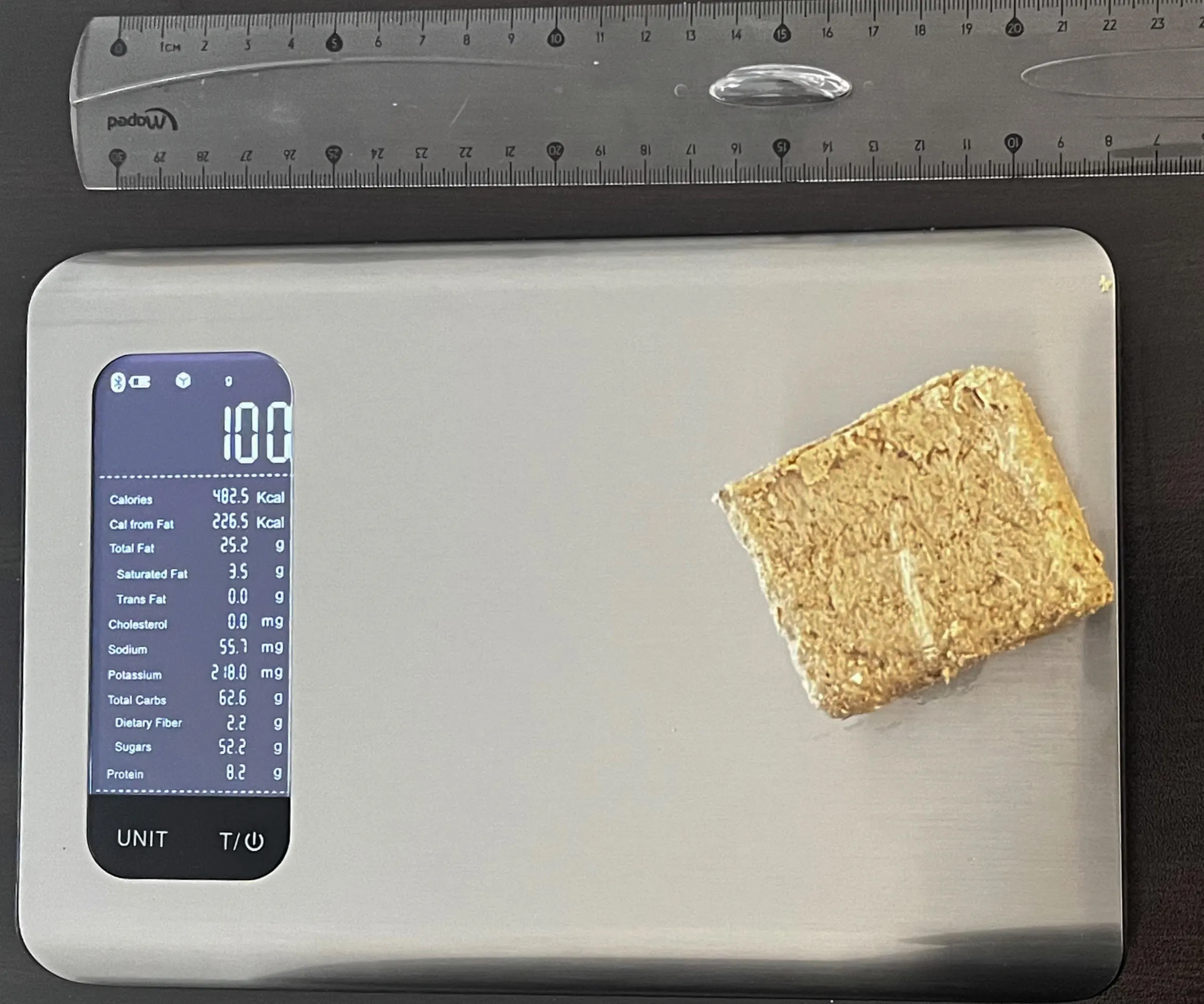
Calories per Serving Size
Although halva is high in calories, it is usually consumed in quantities smaller than 100 grams.
One average serving per person or one ounce (28.35 grams) of halva contains 134 calories.
Calories per Ingredient
In this column, the calories are presented for 100g servings of ingredients found in halva:
| Ingredient | Calories |
| Granulated sugar | 387 |
| Tahini | 595 |
| Vanilla extract | 288 |
| Pistachios | 560 |
Burning Estimates
The table below shows the time and type of activity a person should perform to burn 134 calories (1 ounce of halva) measured by a method called Met or Metabolic Equivalent of a Task (2, 3).
| 70kg person | 100kg person | |
| Walking | 23 min | 19 min |
| Cycling | 13 min | 11 min |
| Running | 13 min | 11 min |
| Aerobics | ~10 min | 8 min |
Comparison of Similar Foods
We compared halva to all foods in our database and found it is in the top 16% of foods high in calories. This means that 84% of foods in our database contain fewer calories than halva.
Compared to nougat, halva contains 33 times more vitamin B1 and more copper.
Regarding tahini, halva contains more magnesium and less saturated fat.
Halva provides more copper, phosphorus, magnesium, iron, vitamin B1, zinc, and vitamin B6 than fudge.
Foods like peanut butter or almond butter contain almost 200 more calories than halva (614 calories per 100 grams).
Compared to honey, halva contains more carbs, so it has more calories.
| Food | Calories per 100 grams |
| Peanut butter | 598 |
| Almond butter | 614 |
| Halva | 469 |
| Honey | 304 |
| Sugar | 387 |
| Maple syrup | 260 |
References
- https://www.researchgate.net/publication/257838119
- https://dergipark.org.tr/tr/download/article-file/3047447
- https://www.researchgate.net/publication/279199271
- https://www.hindawi.com/journals/bmri/2016/8495630/
- https://www.researchgate.net/publication/320124355
- https://www.researchgate.net/publication/287734708
- https://www.researchgate.net/publication/259313291
- https://www.ncbi.nlm.nih.gov/pmc/articles/PMC4428382/
- 2011 Compendium of Physical Activities
Important nutritional characteristics for Halva

|
Glycemic index ⓘ
Source: The GI for white halva https://www.researchgate.net/publication/259313291
Check out our Glycemic index chart page for the full list.
|
55 (low) |
| Glycemic load | 9 (low) |
| Calories ⓘ Calories per 100-gram serving | 469 |
| Net Carbs ⓘ Net Carbs = Total Carbohydrates – Fiber – Sugar Alcohols | 55.99 grams |
| Serving Size ⓘ Serving sizes are taken from FDA's Reference Amounts Customarily Consumed (RACCs) | 1 oz (28.35 grams) |
| Acidity (Based on PRAL) ⓘ PRAL (Potential renal acid load) is calculated using a formula. On the PRAL scale the higher the positive value, the more is the acidifying effect on the body. The lower the negative value, the higher the alkalinity of the food. 0 is neutral. | 18.6 (acidic) |
Halva calories (kcal)
| Serving Size | Calories | Weight |
|---|---|---|
| Calories in 100 grams | 469 | |
| Calories in 1 oz | 133 | 28.35 g |
Halva Glycemic index (GI)
Halva Glycemic load (GL)
Mineral chart - relative view
Vitamin chart - relative view
Fiber content ratio for Halva
All nutrients for Halva per 100g
| Nutrient | Value | DV% | In TOP % of foods | Comparison |
| Calories | 469kcal | 23% | 9% |
10 times more than Orange
|
| Protein | 12.49g | 30% | 38% |
4.4 times more than Broccoli
|
| Fats | 21.52g | 33% | 14% |
1.5 times less than Cheddar Cheese
|
| Vitamin C | 0.1mg | 0% | 53% |
530 times less than Lemon
|
| Net carbs | 55.99g | N/A | 16% |
Equal to Chocolate
|
| Carbs | 60.49g | 20% | 16% |
2.1 times more than Rice
|
| Cholesterol | 0mg | 0% | 100% |
N/A
|
| Iron | 4.53mg | 57% | 12% |
1.7 times more than Beef broiled
|
| Calcium | 33mg | 3% | 42% |
3.8 times less than Milk
|
| Potassium | 187mg | 6% | 62% |
1.3 times more than Cucumber
|
| Magnesium | 218mg | 52% | 10% |
1.6 times more than Almond
|
| Fiber | 4.5g | 18% | 20% |
1.9 times more than Orange
|
| Copper | 1.2mg | 134% | 16% |
8.5 times more than Shiitake
|
| Zinc | 4.32mg | 39% | 22% |
1.5 times less than Beef broiled
|
| Phosphorus | 607mg | 87% | 8% |
3.3 times more than Chicken meat
|
| Sodium | 195mg | 8% | 42% |
2.5 times less than White Bread
|
| Vitamin A | 2IU | 0% | 73% |
8353 times less than Carrot
|
| Vitamin A RAE | 0µg | 0% | 100% | |
| Selenium | 11.5µg | 21% | 58% | |
| Manganese | 0.87mg | 38% | 33% | |
| Vitamin B1 | 0.42mg | 35% | 20% |
1.6 times more than Pea raw
|
| Vitamin B2 | 0.09mg | 7% | 72% |
1.5 times less than Avocado
|
| Vitamin B3 | 2.86mg | 18% | 52% |
3.4 times less than Turkey meat
|
| Vitamin B5 | 0.17mg | 3% | 83% |
6.5 times less than Sunflower seed
|
| Vitamin B6 | 0.35mg | 27% | 36% |
2.9 times more than Oat
|
| Vitamin B12 | 0.04µg | 2% | 65% |
17.5 times less than Pork
|
| Folate | 65µg | 16% | 31% |
1.1 times more than Brussels sprout
|
| Saturated Fat | 4.13g | 21% | 29% |
1.4 times less than Beef broiled
|
| Monounsaturated Fat | 8.19g | N/A | 19% |
1.2 times less than Avocado
|
| Polyunsaturated fat | 8.48g | N/A | 13% |
5.6 times less than Walnut
|
| Omega-3 - EPA | 0g | N/A | 100% |
N/A
|
| Omega-3 - DHA | 0g | N/A | 100% |
N/A
|
| Omega-3 - DPA | 0g | N/A | 100% |
N/A
|
Check out similar food or compare with current
NUTRITION FACTS LABEL
Serving Size ______________
Health checks
Halva nutrition infographic

References
All the values for which the sources are not specified explicitly are taken from FDA’s Food Central. The exact link to the food presented on this page can be found below.

